-
Posts
1,251 -
Joined
-
Last visited
-
Days Won
230
Content Type
Profiles
Forums
Events
Shop
Everything posted by Dad3353
-
Good morning, @Noctua69, and ... ... Plenty to read and amuse you here, and lots to learn and share. Please allow me to congratulate you on your wisdom, getting the right help from Someone Who Knows. Well done. May I also offer my standard words of encouragement..? 'It's the first forty years that are the hardest, after which things sometimes tend to get slightly better. '
-
Good evening, @Chris Wood, and ... ... Plenty to read and amuse you here, and lots to learn and share.
-
A clue, certainly, but confirmation that it needs the attention of someone capable of fixing whatever it is that's amiss. It could still be something simple; just take it to a vet guitar tech.
-
The trap is to access the battery for the built-in tuner (on the bridge pick-up ring...). See here ... But unlike vintage models, the Slash “AFD” Les Paul also comes with a built-in Shadow® E-Tuner built into the bridge pickup mounting ring. The tuner is powered by one #2032 Lithium long-lasting battery, easily accessed from a compartment on the back of the guitar. As for the pick-up, it may well be just the selector switch not adjusted properly, or a wire fallen off inside. I would suggest taking it to a trusted guitar tech, to be checked out and set up properly. It shouldn't cost much for an easy fix, and a good set-up will do wonders for your enjoyment for years to come. It's rare to have a pick-up completely faulty (but does, of course, happen...); it's much more likely to be something very easy for a tech to determine and fix. He/she can also give tips on the other functions of the guitar, such as how to 'split' the pick-ups. Let us know how you get on..? It's a fine guitar with a good reputation; enjoy. Hope this helps.
-
This looks to be a 335 copy, fitted with Artec 'filtertron-type' pick-ups. Probably a little more 'chimey' than standard humbuckers; not particularly outrageous as a choice. Your ears will judge. You may find some info inside the body, using a dentist's mirror or such; sometimes there are maker's marks or pencilled information. Worth a look..? To strip the paint from the headstock, the simplest way is to rub it down with sandpaper. You could, of course, merely paint over it, if it's the finish you want to change. There's unlikely to be any info beneath the paint; this was probably, originally, just a cheap copy from the Far East, or maybe bought as a kit. Worth spending some time on, but not worth spending too much money on. A nice project, and a Good Find.
-
It won't do the poor thing any favours, and won't fix any issues. If you really want to play Spanish from time to time, I'd suggest buying, locally second-hand, a modest nylon-strung guitar that plays properly, and not inflict any more suffering on this one. A quick glance at my local 'LeBonCoin' (I'm in France...) brings up a whole slew of such guitars, from 50€ upwards, that would be far better value. Just my tuppence-worth.
-
Short answer is 'No'. The neck has to come off to be reset; this can only be done correctly and securely by someone with experience in the job. It doesn't look to be a very expensive model, so not worth sending off for this job, so I'd suggest either keeping it 'as is', hung on the wall as decoration and sentimental value, or reading up on how this job can be done and doing it yourself, or with a local wood-working buddy. Basically, the neck has to be removed from the body; this involves using heat (usually steam...) to soften the current glue, cleaning it up, then putting it back together, at the correct angle, using the correct type of glue. It's a simple enough job for a guitar tech who handles acoustic guitars, and can be done on the kitchen table yourself, once the appropriate knowledge (and courage..!) has been assimilated, but can't be done by any other 'brute force and ignorance' method. Lesson learned, but too late, maybe; hope this helps (a little...).
-
You can't go far wrong with an Ibanez, whatever the price point, and this model has an excellent reputation, especially as a starter guitar. There are many models on the market in this range of prices; this Ibanez has nothing to fear from such rivalry. A matt black finish may be subject to marks from use, rather more than a gloss finish, but that's about the only remark not in its favour. Ignore the 'hype', for this and any other that piques your interest, and try it out yourself. You're not likely to be disappointed. Hope this helps.
-
From the description of the way you've chosen the Classic 20, I'd say that you'll just have to accept its peccadilles. You can't buck physics, and if it doesn't change its tone enough presently, it's just the way it's been designed. No pedal will change that, so that's a Good Thing. It would count as being a One Trick Pony, so embrace it for what it is or find a modelling amp that can get close to the 'mild overdrive' that you want, but with greater flexibility. No recommendations (I play 'clean'; I've very rarely found any grit, disto or overdrive that adds anything to my admittedly poor playing, and, anyway, I'm a drummer, soooooo...). Not sure that this helps further; time for a visit to a decent amp shop to try stuff out, maybe..? Keep the Classic 20 as nostalgia, or get it to contribute to the cost of an amp better suited to your needs..?
-
It should be understood that each amp manufacturer, each model, and each technology, have, inherently, very different tonal responses to controls in the (very different...) pre-amps, so there is very little commonality between them. The settings, and range of result, cannot be equated from one to another. The reasons are as varied as the amps themselves : solid-state does not behave as valve stuff, and EL84 valves do not behave like KT88's etc. The effect of 'gain', 'master volume', tone controls differ; some tone circuits are 'flat' with the control at centre, some with the control max anti-clockwise, some (many..!) are never really 'flat', whatever the setting..! All of these factors make every combination of amp-cab useful for its own range, but maybe not so good at another. What sounds good at home may well not have what it takes on stage; even less so on a stadium stage. It works both ways, too; the only way to get a Marshall stack to belt out 'that' sound is to crank it, which makes it a poor candidate for bedroom practice in a town centre high-rise block of flats. In sum, it's 'horses for courses'. One amp for home, another for rehearsals, maybe another for gigs... This is one (of many...) reasons for the advent of Fx pedals in the first place : the ability to 'dial in' the required tone at any volume. It doesn't surprise me at all that the Classic 20 doesn't 'cut it' on stage. Despite having the same power valves (EL84...) as the Vox AC30, the circuits and cab are not at all the same, and the tonal response are chalk and cheese. You can never get a really clean sound from a Classic 20, at pretty much any volume; that's not how the circuit has been designed. They don't do 'loud'; certainly not the 'loud' that an AC 30 does. What are your options..? Find an amp which has the tonal variance that you need, in all the situations, you'll be playing, or have a different amp (and settings...) for each usage, or start building a pedal-board around an amp which ticks most of your boxes. It's not really a case of 'SS' v 'Valve' v 'Modelling'. It's just that all rigs have their upside and downside. Such is Life. Hope this helps.
-
Good evening, @Gooner, and ... ... Plenty to read and amuse you here, and lots to learn and share. A Good Question, but we will need a little more detail in order to really help. How long have the strings been on the guitar(s), and how long have you been playing..? Do you play with fingers only, or with a plectrum..? Is this always the same string breaking, or is it just any string..? Does it break whilst tuning up or whilst playing..? Do you use a tuner when tuning the guitar(s)..? Is the break always at the same spot along the string length..? What gauge are the strings..? Over to you...
-
Good evening, @Gcsltmc, and ... ... Plenty to read and amuse you here, and lots to learn and share. I can't help with your request (I'm in France...), but others will be along, so... Watch this space.
-

Terminology, formulas and more formulas
Dad3353 replied to cyman1964ukg's topic in Theory and Technique
Good evening, @cyman1964ukg, and ... ... Plenty to read and amuse you here, and lots to learn and share. Simon... It's actually a lot more simple than you're making it, and you're very nearly 'there' with your current reflections in chord construction. The only issue is that you're looking for a 'mathematical' 'logic' that just is not there (and doesn't need to be...). Your starting point of creating with 'triads' (alternate notes of the scale...) works well for Major and Minor chords, and only needs extending a touch by adding the next 'alternate' note to the triad to get the Major 7th and Minor 7th chords. It's easy to visualise on a piano keyboard, adding the 'B' to the 'C' chord (the one below the octave 'C'...) creates the CMaj7 chord. This is consistant when doing the same to the 'DMin' chord (add the next alternate note, ie: the octave 'C'...) and you're crated the DMin7 chord. Continue for each diatonic note of the 'C Major' scale, using alternate notes from the scale, and you've got most of the chords needed for many, many songs. If we 'break' this chord system, and use a flattened '7th' (ie: 'Bb' instead of 'B'...) we get a chord which, when played, has a sonic tendency to want to 'resolve' to the CMajor, which is why it takes the name 'Dominant'. That Bb is not in the C major scale, but as it's a very powerful sounding chord, it has it's place in so many songs, from cowboy campfire songs to much early Bob Dylan stuff. It's a staple in the chord Pantheon. However, the chord naming of 'C7' tricks us into assuming that it's got a '7th' in it. It has not; it's a flattened 7th..! It's only through historical usage that the chords have these names, not 'logic', so get used to it..! As for extending further these chords, we are simply adding another alternate note from the diatonic scale, so, for the 'C' scale, adding a 'D' above the octave gives us a 9th', adding an 'F' is an 11th, then adding the 'A' is a 13th. No point adding further, as we'd only be repeating the notes we started with, but two octaves up. With these 'extended' chords, many other nots would be left out (usually the 5th and 7th...), as too many notes spoil the broth become muddy. I wouldn't worry about 'modes' for a while; they are not really 'mainstream', so get the basics down 'pat' before following down that rabbit hole. Interesting as it is, there's much more practical stuff to assimilate without delving further into It. Hope this helps. Douglas -
Good evening, @XinDi-WaRRior, and ... ... Plenty to read and amuse you here, and lots to learn and share. We, on this Forum, have all, without exception, started from the same 'zero' baseline, so we know where you're coming from. We all learn differently, with differing objectives and time constraints, but it is 'easy' for no-one. There is no secret that the best way to get started is with a one-to-one guitar tutor, even if it's only for a few lessons, as this paves the way to setting realistic, obtainable objectives with the right techniques. One essential, for any beginner, is to obtain a large supply of Patience, and keep it topped up at all times. One learns in stages, and there will be moments when progress seems slow, or even regression. This is normal; there will also be 'light-bulb' moments when things become blindingly clear, and one realises that progress has, indeed, been made. I'll end with my usual 'words of encouragement' ... It's the first forty years that are the most difficult, after which things sometimes tend to get slightly easier.
-
Good afternoon, @Fingers n thumbs, and ... ... Plenty to read and amuse you here, and lots to learn and share. A Word to the Wise : The key to beginning on the guitar is Regularity and Patience. Short, Regular practice sessions are far better than long hours. It's better to consecrate 15 minutes, twice a day, every day, than an hour's session sometimes skipped. Don't try to rush things; the fastest way to getting fast on the guitar is to play SLOWLY and take your time. Other than that, follow, diligently, the method of your Tutor (ask him/her about these recommendations..?), and make sure that you always have a Big Bucket of Patience on hand. That's the key. Have fun; we've all been there.
-
Apparently, there's a 'rule' set in the software somewhere whereby at least five posts are to be made before allowing these luxury 'extras'. It's to avoid 'spam' posts giving full access, I think. Still, you're OK now, soooooo...
-
Good evening, @upside downer, and ... ... Plenty to read and amuse you here, and lots to learn and share.
-
You're right, no impact on sound nor playing. It will probably remain stable for years, but keep an eye on it now and again. It could be touched up with a furniture touch-up pen, just to hide it a little, but just put it down to 'character' and play on.
-
Good morning, @Diary Of An Axeman, and ... ... Plenty to read and amuse you here, and lots to learn and share.
-
Good afternoon, @Runningblueowl, and ... ... Plenty to read and amuse you here, and lots to learn and share.
-
Trs is for headphone alone. Trrs is for headphones with a mic. It's the former that's required for getting audio out for the PA.
-
Good afternoon, @kaigr0hl, and ... ... Plenty to read and amuse you here, and lots to learn and share.
-

What Guitar-related Christmas Presents Did You Get?
Dad3353 replied to Crusoe's topic in General Discussion
I had already pre-empted Christmas in offering to myself my bucket-list guitar : a Hofner President E2 thinline, Florentine cut, having foolishly traded away the first one I had, late '60s. Half a century later, I got this one from a Reverb seller in Sweden. The Christmas gift..? Our Daughter, thinking (rightly...) that it would be difficult to find something I'd want/need that I didn't already have, posted a sum of money into my bank which covered the cost of the hard case and shipping of my dream guitar. Much appreciated, and a Very Nice Surprise. Here's a (bad...) photo of the delivery and unpacking of the guitar...






